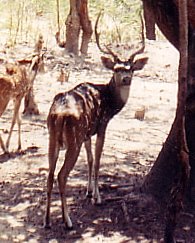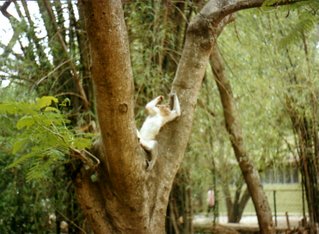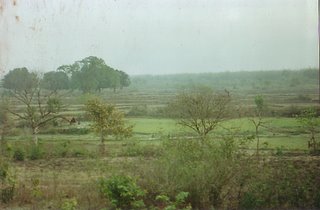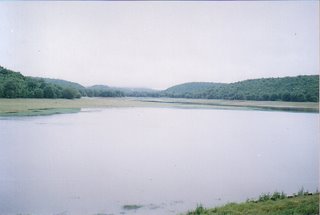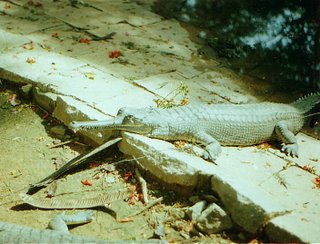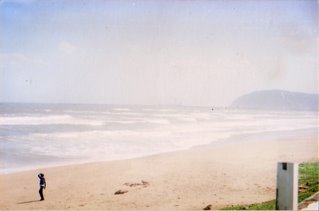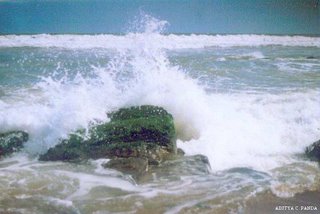Bangiriposi is a small town on the northern border of the Similipal Tiger Reserve, Orissa. To reach it from the Jashipur side, one has to negotiate a ghat road called the Bangiriposi Ghat. In days long gone, this ghat used to be famous for tiger sightings, especially at night. However, like the rest of India, increasing human interference has taken its toll of wildlife here and there had been no confirmed tiger sightings since the past 15 years or so.
In early August ’06, a truck negotiating the ghat lost control over a tight bend and rolled over. A group of seven or eight village boys, who had come curiously to look at the wreck, were returning home when one of them spotted an animal standing on a cliff on the hill. It was around 11 a. m. and all of them saw it clearly. Most of them had never seen one before, but they recognized it immediately. One of them uttered the universal Oriya name for tiger, leopard, hyena and sometimes even fishing cat- “Bagha”.
The boys were not familiar with big cats and none of them could actually tell which of the above this was. One of them, Baikuntha, happened to be working as a domestic help at my residence and I came to know of this incidence from him. To help in identifying the animal I’ve listed his observations below:
(a) The animal was the size of a domestic bullock
(b) It had vertical stripes
(c) Its had an immense head, over a foot in diameter
(d) It stared down at them boldly
(e) When they started yelling and gesturing at it, it turned its head to look over both shoulders, stared at them, snarled, and walked back into the forest with controlled haste
When I heard these observations, I was more or less confirmed that it could be nothing but a tiger. On questioning him further, Baikuntha said that livestock kills happened, though infrequently. There were lots of goat and sheep kills, which could have been the handiwork of a leopard, but sometimes a cow or bullock would be lost. Even a largish leopard would find it difficult to kill bullocks. This, to me, confirmed the fact that the forests around Bangiriposi were part of at least one tiger’s territory. I mentioned the incident to Surjit Bhujabal, the chairman of Wild Orissa and he interviewed Baikuntha over phone for over half an hour. He too was convinced. In a week or so, fellow wildlifer with WO Dillip Naik and I were on our way to Bangiriposi. We were short on time, having a little over a weekend to spare, but we tried to make the best of what we had, and the following is what would have been my diary entries over the period:
Saturday,
October 28, 2006
We arrived at Jashipur very early in the morning after a tiring, 280 km overnight bus journey from Bhubaneswar. I had been to Jashipur before and knew the way around a bit. From the bus stand we went to a ‘dhaba’ owned by the governor of WO’s regional chapter, Pramod Panda. We had hardly slept the previous night and should have been making the best of the dhaba’s rope cots now, but the fresh morning air, doped with the mist of winter on the anvil, the sal trees, and just the fact that we were so close to the Similipal Tiger Reserve drove all signs of sleep away. After tea, we took a brief walk in the Project Tiger office premises nearby. It doubles up as a memorial to ‘Khairi’, a tigress kept as a pet by the first field director of Similipal Tiger Reserve, Mr. Saroj Raj Choudhry. The bungalow where the tigress and her master lived is now a museum and her grave is right in front of the bungalow, on the lawn. The compound is filled with sal trees and the trees harbor hundreds of Blossom Headed Parakeets. Mesmerized by the sight, I started yearning (like I have thousands of times before!) for a telephoto lens to go with my Vivitar. Dillip bhai did the best he could with his little digicam.
We were met by Mr. Panda around 8:30 a. m. He had made arrangements for our stay at Bangiriposi before hand and boarded us on to a bus to cover the very bumpy and slow 60 or so kilometers to Bangiriposi. The bus was filled with local tribals. I noticed a few of them carrying cocks in bags. These were for the cockfights scheduled to take place on the day at the weekly ‘haat’ at Bisoi, 15 kms ahead of our destination. We reached Bangiriposi around 12:00 p. m. and Baikuntha was waiting for us at the forest check gate that marks the end of the ghat and the beginning of the town. Put up at the “Similipal Resort” a small privately owned guesthouse, we were just in time for a delicious brunch of rice and country chicken. A little bit of jungle talk with Baikuntha revealed that elephants frequented the paddy fields around the place. Since we knew we couldn’t do much tiger tracking that evening, we planned the night on one of the crop protection machans, hoping to see elephants. Sleep finally caught up with us and we retired for a siesta. Baikuntha assured us that he’d be back by 4 O’ clock.
It was well past five, and there was no sign of Baikuntha. Losing patience after another half hour we decided to walk down to his brother’s ‘paan’ shop, hoping to find him there. We met him half way, and after scolding him to our hearts’ content, moved on. We were supposed to be on the machan by then, but the owners of the machan had cooked mutton at home and wouldn’t climb onto it until they finished dinner… around eight or eight thirty. Good thing I had brought my 25, 00, 000 candle power spotlight along! The three of us had dinner too and waited for the owners to arrive.
They arrived before eight and, happy about the ‘early’ start, we began our trek to the end of cultivation, where jungle meets paddy field and elephants descend at the onset of winter to feast on the ripening paddy. We left the tribal settlements behind and had another five or six kilometers to walk through the paddies. After covering half the distance, we heard the watchers yelling. The elephants had descended! But this posed a huge risk to us. We didn’t know if any of the elephants had crossed the line of machans to feed peacefully on the nearer paddies. And trust me; paddy fields in October are not the best places to meet wild elephants in India. That too at night! We talked only in whispers and looked carefully around every boulder, every bush, and every clump of tree. There was also the possibility of running into sloth bears and we used the spotlight where necessary. By the time we were just nearing the machans, all the 25, 00, 000 candles were out. Without the spotlight we couldn’t go any further. It was risky to shout out to anybody on the machans. When elephants raid crops, they know people will cause trouble. But they are hungry, and will resent. There was no option but to walk back to the guest house. The next morning we heard that four elephants, including a calf, had come.
Sunday,
October 29, 2006
Baikuntha was late again. He was supposed to arrive at five in the morning and it was well past seven now. We planned to explore the site of the tiger sighting. Breakfasting at the dhaba, we finally found Baikuntha, smiling shamelessly. We walked the seven kilometers to a temple on the ghat. On the way we came across rhesus macaques, and, an over turned oil tanker. The petroleum it was carrying had spilled and the air bore its nauseating stench. This was the place where the boys were standing over two months ago and Baikuntha pointed to us the rock from which the King stared down at them.
We started our ascent to the rock from the temple. It was on the northern side of the road. A clear spring flowed behind the temple and the hike up the hill was extremely steep, almost vertical at times, and rocky. It was thickly wooded and we found a cave halfway. The entrance to the cave was sandy, and we made out the pugmarks of a large, male leopard. He must have been using it as a temporary den. I say temporary because the view from the cave was of National Highway 6. We also missed the distinct, pungent smell of the big cats and there were no remains of kills. There were also the pugmarks of a bear. Photo session later we trekked on. The rock on which the tiger had stood had no pugmarks around. We didn’t expect any. We didn’t expect the tiger to reside on the hill. It was too disturbed to have a resident tiger. On the western side of the hill is a deep gorge, thriving with small game, like barking deer and hare. It also provides cover to elephants during the day. Sambar and chital are also present, according to sal leaf gatherers, though in very small numbers. Peafowl and jungle fowl also thrive. This is excellent diversity for a reserve forest in India, that too with a national highway passing through it. We started our descent and were back at the temple by 12:30. Thumbing a lift from a passing tractor, we were back at camp for a refreshing bath and sumptuous lunch. It had been a satisfying morning, but we were determined to see the elephants that night and this time I made Baikuntha stay with us through the afternoon.
We were on our way by five. The spotlight had been charged fully, batteries and cameras and other sundry equipment checked and double checked extra carefully. The hills marking the border between cultivation and wilderness were beautifully silhouetted against a setting sun and the paddy fields in the foreground, golden with the ripened crop, enchanted us. As we got closer to the hills, the serenity was broken by an illegal stone quarry. They use dynamites to blow up sections of hills and cause are extremely damaging to the environment.
We finally reached our machan. But the owner thought it would be better for us to sit on a rock, right on the path of the elephants. We agreed. It’d give us a better view. There were other machans to our right. When the elephants descended, these were expected to yell, burn tyres and in short, create pandemonium. This would cause the pachyderms to try and escape through our side of the area and offer us a clean view. The plan seems perfect. The rest depends on the elephants and we hope they come tonight like they have for the past two nights
The moon was up and we waited for it to go down so that the nervous giants could get a confidence boost. We talked only in whispers and our ears were craving for alarm calls… there were none expect a few jackal calls and a langur’s “whoomp- whoomp- whoomp”. This disappointed us. The langurs almost assured us that there were no elephants nearby then.
It was now eight o’ clock and most of us were dozing. A while later, my subconscious registered a whooshing noise. All of us were now wide awake, expecting the elephant (we assume it’s a loner) any moment. There was no noise from the machan to our right. Everybody expected the elephants to come after the moon went down and stole the opportunity for a nap. The elephants got the better of this. They used the opportunity to escape to the fields near the ghat. We lost our sighting, which was obviously frustrating, but I honestly couldn’t help admiring the intelligence of the animals!
Monday,
October 30, 2006
Today was our last day in Bangiriposi. We decided to have a last look at the ghat section. We reached the temple at around 9:00 am and got news that a big cat had been sighted a few days ago. There was a National Highways Dept. camp on the far side of the ghat and a man had been posted there to guard sundry construction machinery. On the evening of the 28th, incidentally our day of arrival, at around 5:00 pm, while there still was light, he had seen a leopard cross from the southern side of the ghat to the northern side. He said that this was a regular happening. This was encouraging news indeed. We had very little time in our hands as we were leaving the same evening. Trying to make the best of what we had, we scoured the nearby forests. We could make out the pugmarks of two leopards, one medium sized and the other small, but were not sure if they were male and female or mother and cub or simply two unrelated leopards of different sizes. They were made at different times but are pretty much at the same place, right next to the road. The guard told us that he sees two different leopards and we assumed this to be true. We saw a jungle hen pretty close to the highway and, as we had already learnt before, the forests were moderately rich in jungle fowl, peafowl, barking deer and occasional chital and sambar. All these reinforced our assumptions.
Our findings in the area make us infer that the ghat is used by at least three leopards, which are most probably resident. The ghat is part of a very important wildlife corridor connecting the Similipal Tiger Reserve with the Chaibasa and Saranda forests of Jharkhand to the north. Elephant migrate between these two very rich habitats via this corridor and we are very sure that it is also the part of at least one tiger’s territory. Low prey density and high human interference have caused the few remaining tigers here to wander large distances in search of prey and mate and it is very likely that there is tiger movement between Jharkhand and Orissa through this patch.
This corridor however, suffers from some very major threats. A national highway cuts right through it and heavy vehicles ply regularly. Apart from disturbing the habitat by their noise and pollution, these vehicles are prone to accidents on the ghat. It goes without saying that they definitely heighten the chances of road kills. Oil spills from petroleum tankers are extremely damaging. In order to keep this corridor viable, it is absolutely necessary to close the ghat section from all traffic at least between 6:00 pm and 6:00 am. All road expansion work should also be stopped on the ghat. The fact that the ghat lies within the Similipal Biosphere Reserve bolsters our plea. Another threat is from the illegal stone quarries. It is the administration’s responsibility to ensure that these are kept under check.
Proper protection will definitely cause increased usage of this corridor by big cats and elephants alike. This is extremely important as the tiger population of Similipal is now under many question marks and human-elephant conflict in the region is on the rise. The pachyderms need the right of passage in order to find new feeding grounds and the big cats need to wander farther in search of mates in order to diversify their diminishing gene pool.

